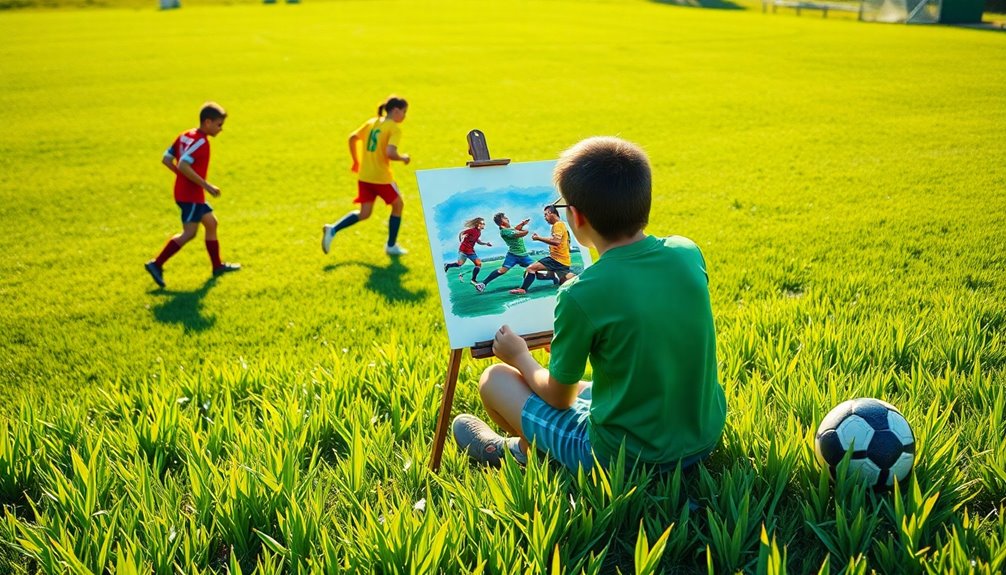
Art Meets Sport: Mastering Soccer Drawing Techniques
February 10, 2025Mastering soccer drawing techniques can elevate your artwork to capture the sport's energy and emotion. Focus on dynamic movements, like sprinting and dribbling, using lines of action to show direction. Utilize a mix of graphite pencils and high-quality paper to create depth and texture. Pay attention to player expressions, as their emotions tell powerful stories. Understanding perspective is key; use vanishing points to depict the field accurately. With these techniques in your toolkit, your illustrations will resonate with fans. Stick around, and you'll discover even more tips to refine your artistic skills and engage your audience.
Understanding Soccer's Dynamic Movements
Capturing soccer's dynamic movements starts with observing players as they sprint, dribble, and change directions.
You'll want to focus on the fluidity and energy of these actions, as they naturally create dynamic poses that showcase the sport's intensity. As you watch, notice how players cover an average of 10 to 12 kilometers during a match; this endurance is vital to depict in your drawings. Understanding the biomechanics behind key movements, like kicking and heading, enhances your illustrations, especially when considering advanced techniques used by skilled players. Additionally, mastering ball control allows players to maintain possession while executing complex dribbles.
Pay attention to the angles and body positions, as these insights will help you portray accurate motion. The interplay between players offers a wealth of inspiration; their positioning and movement patterns can lead to more dynamic compositions in your artwork. To capture the essence of defense, consider the importance of team coordination as players work together to limit opponents' options.
Don't forget to utilize reference footage or live sketches from matches. Observing the timing and rhythm involved in passing and receiving the ball will give you a deeper appreciation for the sport's nuances. By honing in on these aspects, you can elevate your drawings, bringing to life the excitement and energy that soccer embodies.
Essential Drawing Materials
To create stunning soccer illustrations, you'll often rely on essential drawing materials that enhance your artistic expression. Your material selection can greatly impact your drawing techniques, so it's crucial to choose wisely.
Here are some essential items to examine:
- Graphite Pencils: Ranging from H (hard) to B (soft), these are perfect for detailed sketches and varying line weights.
- High-Quality Sketch Paper: Look for paper with a weight of at least 200 gsm to withstand erasing and layering without damage. Incorporating techniques from endurance building workouts can help improve your focus during long drawing sessions. Additionally, practicing leg strength can ensure you maintain a comfortable position while drawing for extended periods.
- Blending Stumps or Tortillons: These tools help create smooth shifts in shading and texture, enhancing the realism of your soccer illustrations.
- Colored Pencils or Markers: They add vibrancy to your artwork, allowing you to depict team colors and dynamic motion in soccer scenes.
- Don't forget about a kneaded eraser, which allows for precise corrections and highlights—perfect for refining details in your soccer drawings. Additionally, practicing fundamental techniques will improve your overall drawing skills and provide a solid foundation for more complex illustrations.
With these materials in hand, you'll be well-equipped to bring the excitement of the game to life on paper.
Capturing Player Expressions
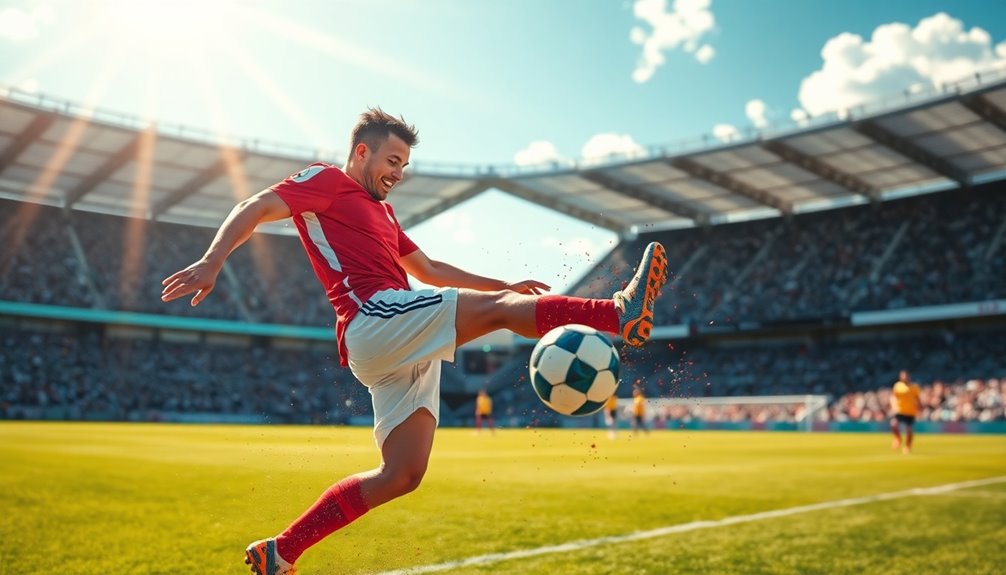
Every brushstroke and pencil mark can breathe life into your soccer illustrations, especially when you focus on the emotions that players convey during the game. To capture authentic player expressions, pay close attention to their eyes and mouth. These features are essential in illustrating emotions like determination, joy, or frustration. Use facial expression techniques to highlight these elements, enhancing the emotional connection between the viewer and the artwork. Unity on the soccer field is essential for success, and it often manifests in the expressions players display during intense moments.
Dynamic poses and body language also play an important role. Clenched fists or extended arms can tell a powerful story about a player's experience during critical game moments. Studying reference images from live matches or player interviews can help you understand the intensity and passion that soccer brings. Remember the insights from team unity in soccer, as cooperation among players often reflects in their expressions during matches. Emphasizing teamwork and collaboration can further enhance the emotional impact of your illustrations.
Don't shy away from experimenting with varying line weight and shading techniques. These methods can emphasize a player's emotional state, adding depth and movement to your drawings. The dedication to training and teamwork can be a driving force behind the expressions players exhibit during the game.
Incorporating elements like the soccer ball or crowd reactions provides context, amplifying the emotional impact of the player's expression. By mastering these techniques, you can create compelling illustrations that resonate with viewers on a deeper level.
Techniques for Motion Illustration
Illustrating motion in soccer requires a keen eye for dynamic lines and curves that convey speed and direction. To effectively capture motion dynamics, focus on the players' movements and the energy they exude. The role of the striker often exemplifies the need for fluid motion and precise positioning during a game.
Use techniques like foreshortening to enhance depth, making your figures appear more three-dimensional. Quick sketches of key moments, such as a kick or sprint, can help you grasp the fluidity of action and anatomical positions.
Here are some techniques you might find useful:
- Dynamic Lines: Use sweeping lines to indicate direction and velocity.
- Foreshortening: Create depth by altering proportions, emphasizing movement.
- Reference Materials: Study photos or videos for realistic postures and gestures.
- Line Variation: Experiment with thickness and shading to convey intensity and momentum.
Incorporating close ball control techniques into your drawings can further enhance the representation of players' agility and precision in motion.
These methods not only improve your technical skills but also enhance your visual storytelling. By capturing the essence of motion, you'll bring the excitement of soccer to life in your drawings, engaging your audience and showcasing the sport's dynamic nature.
Perspective in Soccer Drawings
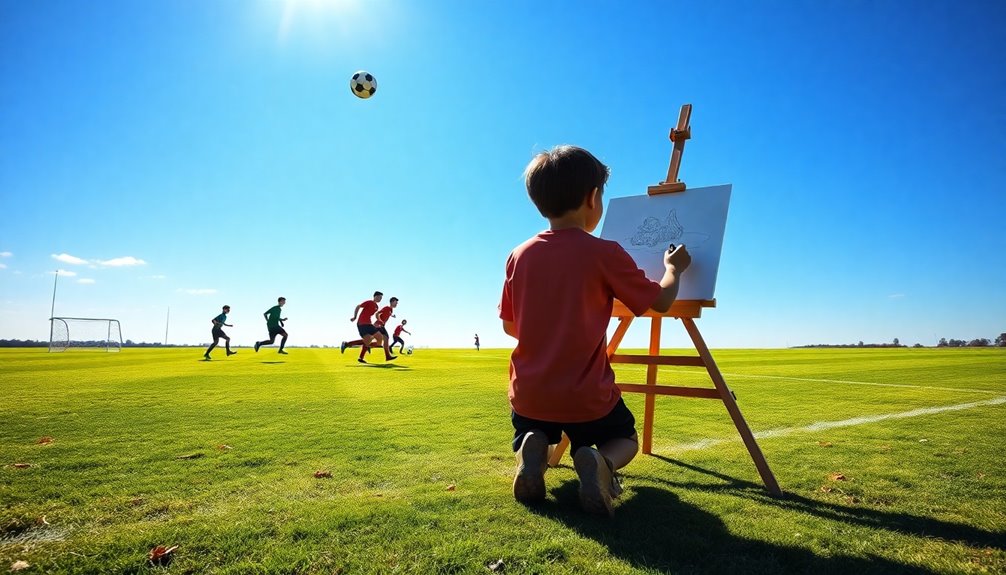
Mastering perspective in soccer drawings is essential for creating compelling and realistic scenes. Understanding the vanishing point is vital, as it allows you to depict the field and players accurately relative to their positions.
Using one-point perspective can dramatically illustrate scenes where players face the viewer, emphasizing the dynamic action of the game. This technique helps draw attention to the intensity of a moment, making your drawing more engaging. Incorporating elements from defensive stance drills can enhance the portrayal of players' body positioning and movement.
On the other hand, two-point perspective is beneficial when you want to showcase players in motion along the sidelines. This approach provides a more realistic representation of their movement and spatial relationships, giving your artwork depth and dimension.
Incorporating foreshortening techniques also plays a key role in conveying the action and intensity of soccer. By shortening limbs and bodies, you can create a sense of movement that feels more dynamic and three-dimensional. Observing real-life soccer matches and studying the angles of view can greatly enhance your ability to replicate the various perspectives encountered during play. By mastering these techniques, your soccer drawings will truly come alive. Additionally, understanding the importance of adaptability in formations can inspire unique compositions that capture the fluidity of player movements on the field.
The Role of Light and Shadow
How can light and shadow transform your soccer drawings into dynamic works of art? Mastering the use of light and shadow can elevate your illustrations by adding depth and dimension.
By understanding the direction of your light sources, you can establish consistent shadow placement that enhances realism. This attention to detail not only brings your players and the ball to life but also captures the energy of the game. Understanding the game's structure, including the importance of stoppage time, can also inform your portrayal of action moments, as stoppage time can significantly affect game momentum.
Consider these key techniques to enhance your work:
- Use a range of values: From dark shadows to bright highlights, varying your tones can convey movement.
- Identify light sources: Knowing where the light is coming from will guide your shadow placement.
- Experiment with hatching: Techniques like hatching and cross-hatching can add texture and contrast.
- Convey mood and atmosphere: The interplay of light and shadow can make your artwork more engaging and lifelike.
Emphasizing Rhythm in Art
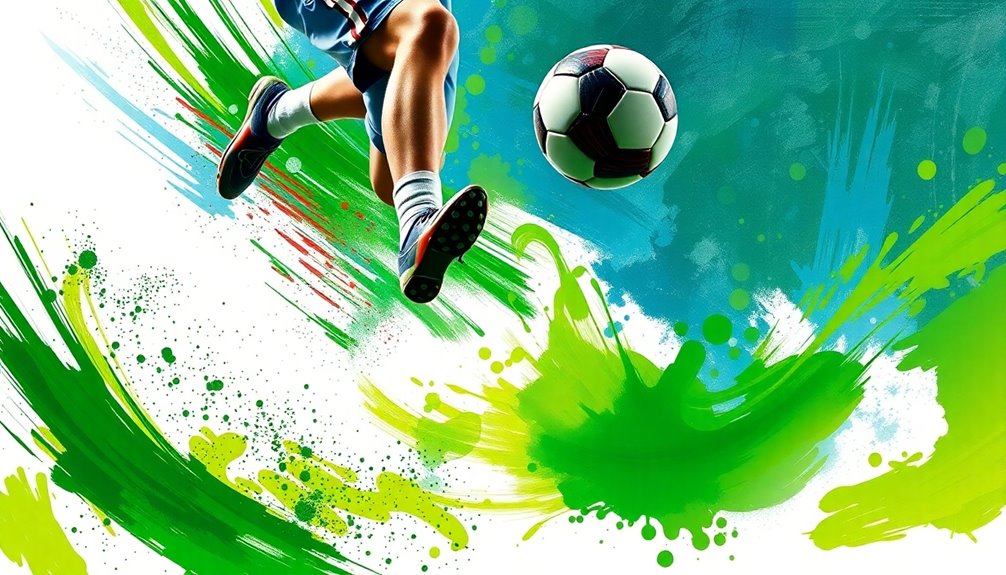
To capture the rhythm of soccer in your artwork, focus on the flow of movement through your brushstrokes.
Use varied timing and composition techniques to guide the viewer's eye, creating a dynamic visual experience.
Rhythm in Brushstrokes
Rhythm in brushstrokes can transform a blank canvas into a vibrant depiction of soccer's dynamic energy. By mimicking the fluid movements of players, your brushstroke techniques can capture the essence of the game in every stroke. As you explore rhythm, consider how your choices can evoke the highs and lows of a match.
- Vary the pressure and speed of your strokes to reflect intense moments.
- Utilize repetitive patterns to create a sense of movement and flow.
- Integrate a rhythmic structure in your composition to guide the viewer's eye.
- Experiment with color and texture to enhance the emotional impact.
These elements aren't just technical; they're integral to your rhythm exploration. When you incorporate these techniques, you invite your audience to feel the excitement and tension of the game.
Your strokes can narrate the story of a match, making each painting not just a visual experience but an emotional journey as well. By mastering rhythm in brushstrokes, you'll elevate your soccer drawings, capturing the sport's essence in a way that resonates deeply with viewers.
Flow of Movement
Capturing the flow of movement in soccer drawings is crucial for conveying the sport's energy and excitement. To achieve this, you should conduct movement analysis by studying the rhythm of players' motions. Focus on key actions like dribbling, passing, and shooting, which will help you create dynamic poses that reflect the intensity of the game.
Incorporating lines of action and curves into your artwork is essential. These elements convey energy and momentum, emphasizing players' positioning on the field. You can also enhance the sense of rhythm by utilizing repetition of motifs, such as the arc of a kick or the trajectory of the ball. This creates a continuity that draws viewers into the action.
Experimenting with varying line weights and shading techniques allows you to reflect the speed of players' movements more effectively. Observational practice is key; sketch players in real-time during games to develop a deeper understanding of the fluidity and grace inherent in soccer's rhythmic flow.
Timing and Composition
Understanding the interplay of timing and composition can elevate your soccer drawings to new heights. Just like music, capturing the precise moment of action in your artwork creates a rhythm that resonates with viewers. By employing effective timing techniques, you can convey movement and energy in your soccer scenes.
To enhance your compositions, consider these strategies:
- Dynamic Angles: Use varied perspectives to mimic the players' movements, adding depth and excitement.
- Repetition: Reinforce key elements, like a player's stance or motion, to establish a rhythm that pulls viewers in.
- Negative Space: Balance the empty areas in your drawing to create focus, much like pauses in music enhance emotional impact.
- Flowing Lines: Incorporate lines that guide the eye, echoing musical motifs that engage the audience.
Creating Depth and Dimension
To create depth and dimension in your soccer drawings, you'll want to focus on light and shadow to give your players and the field a three-dimensional quality.
Incorporating perspective techniques helps guide the viewer's eye, while foreground elements can enhance the overall composition.
Utilizing Light and Shadow
Effective use of light and shadow can significantly enhance the depth and dimension of your soccer drawings. By determining the light placement in your artwork, you can create realistic highlights and shadows that bring your subjects to life.
Pay attention to how different surfaces interact with light; for instance, the shiny texture of a soccer ball contrasts with the matte finish of a player's jersey.
To achieve this, consider these techniques:
- Use a variety of tonal values to represent different textures.
- Employ hatching and cross-hatching to illustrate shadow intensity effectively.
- Observe real-life soccer scenes to understand how light impacts movement.
- Incorporate gradients in shadow areas for smoother changes between light and dark.
Perspective and Foreground Elements
In soccer drawings, mastering perspective and incorporating foreground elements are key to creating a dynamic sense of depth. Understanding linear perspective is essential; it involves making parallel lines converge toward a vanishing point, giving your composition a three-dimensional effect. Use perspective adjustments to position players and the ball, making them appear larger and more detailed in the foreground.
Apply foreground techniques by overlapping shapes in your drawing. This establishes a hierarchy, with foreground elements blocking parts of the background, creating a layered effect. Experiment with varying the size and detail of objects based on their placement. Larger, more detailed elements should be in the foreground, while smaller, less detailed ones recede into the background.
You can also enhance depth perception through shading and color gradients. Lighter colors should recede, while darker tones advance. This technique will pull the viewer's eye into the scene, emphasizing the action on the field.
With these strategies, you'll create engaging soccer drawings that not only convey motion but also invite the viewer to explore the depth of the composition.
Using Color to Convey Emotion
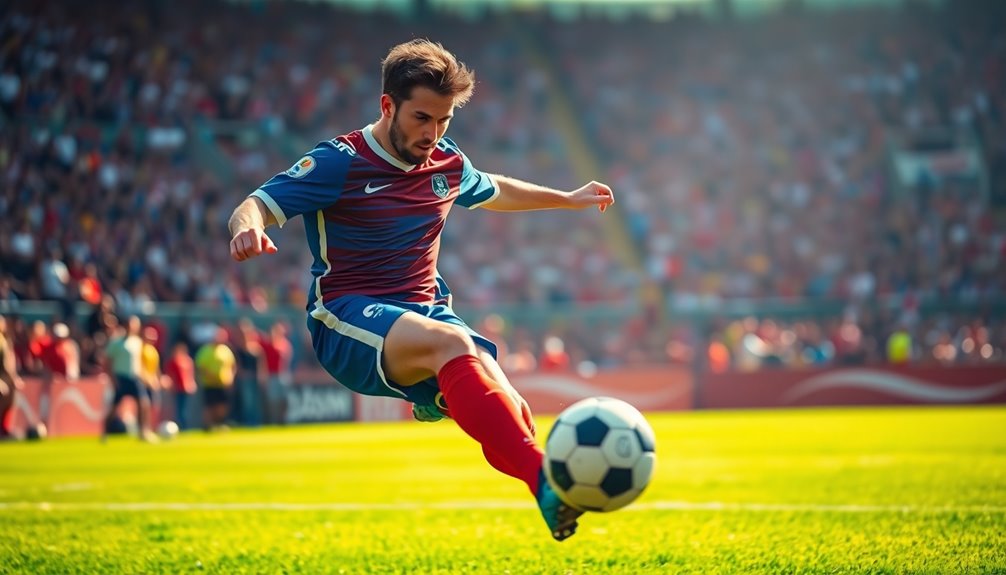
Color plays an essential role in conveying emotion in soccer drawings, influencing how viewers connect with the artwork. By understanding color symbolism and using emotional palettes, you can evoke specific feelings that enhance the narrative of your piece.
Warm colors like red and orange can capture the excitement of a goal or a fierce tackle, while cool colors such as blue and green can create a sense of calmness, perfect for moments of reflection.
To effectively use color, consider these points:
- Contrast: Pairing colors can highlight key actions, like a player celebrating a goal.
- Shades and Tints: Different shades can represent varying emotional intensities; vibrant yellow signifies joy, while muted yellow may indicate nostalgia.
- Gradients: Incorporating color gradients adds depth and movement, emphasizing the sport's dynamism.
- Context: Use colors that resonate with the scene's mood, ensuring they align with the emotions you wish to convey.
Combining Realism With Abstraction
Mastering the blend of realism and abstraction can elevate your soccer drawings, making them more dynamic and emotionally resonant. By combining realistic elements with abstract forms, you can capture the intense movement of players while conveying the game's emotional depth.
Use loose brush strokes and exaggerated proportions to express the dynamic energy of a match. This technique allows you to create a sense of speed and motion, drawing viewers into the action.
Employing a limited color palette can also enhance your work, emphasizing key aspects of the game and delivering a powerful visual narrative. Consider incorporating abstract backgrounds or shapes; they can enrich your composition while allowing the players to stand out.
This balance keeps the viewer engaged and maintains a sense of atmosphere.
To achieve realism, study the anatomy and movement of soccer players—this knowledge is essential. Once you have that foundation, feel free to creatively alter these elements to fit your abstract vision.
The result will be unique and expressive artworks that resonate with the energy of the beautiful game, showcasing your ability to blend realism with abstraction seamlessly.
Sketching Game Strategies
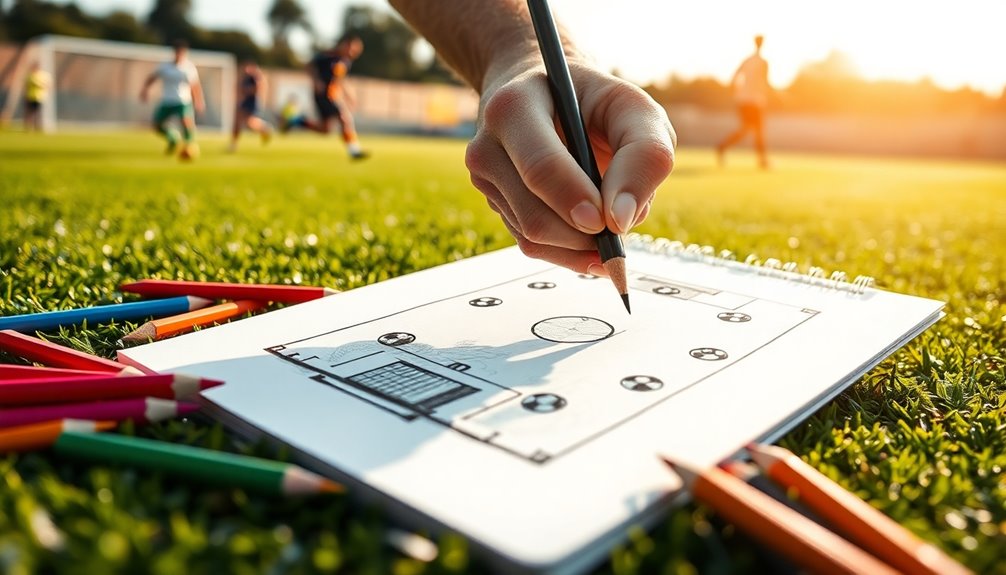
Sketching game strategies is essential for visualizing player movements and tactical formations on the soccer field. By breaking down the field into sections, you can effectively represent player positions and their interactions. Use arrows and lines to indicate player movements and passing lanes, as this helps capture the flow of the game and the essence of the tactical formations.
To enhance your sketches, consider the following:
- Incorporate symbols for different player actions (e.g., circles for dribbling, Xs for passing).
- Vary line weights and styles to differentiate between active and passive players.
- Practice common formations like 4-4-2 and 3-5-2 to understand player interactions.
- Focus on how players adapt their positions based on the game flow.
Illustrating Iconic Moments
Capturing iconic moments in soccer requires an eye for detail and an understanding of movement. When illustrating legendary players, focus on their dynamic poses during key actions, like a powerful kick or a dramatic save. These moments convey the game's intensity and excitement.
To create depth and movement in your drawings, study the use of lines and shading. Highlight the energy and fluidity of soccer movements by paying attention to the ball's trajectory and the players' expressions. These elements illustrate the emotional highs and lows of iconic goals, making your artwork resonate with fans.
Utilize reference images from famous matches to grasp the anatomy and positioning of players during significant actions. This practice will enhance your accuracy and authenticity.
Don't hesitate to experiment with different angles and perspectives — a low or high viewpoint can create a more dramatic representation of the scene.
Engaging With Fans Through Art
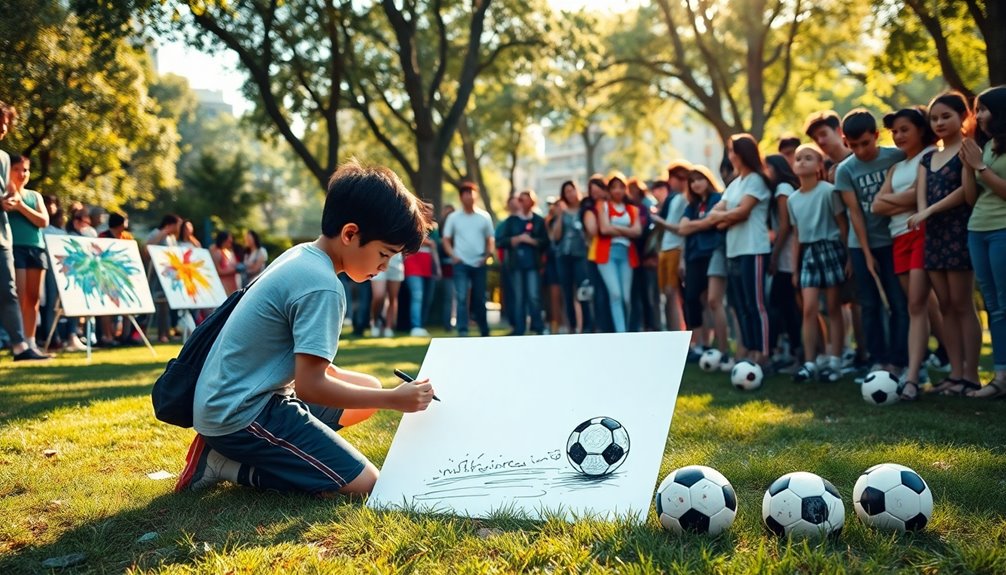
Art has the power to create a unique bond between fans and the sport of soccer, enhancing their overall experience. By integrating art into the soccer culture, you can deepen your emotional connection to the game.
Engaging with fans through art fosters a vibrant community where everyone feels included and valued.
Consider these approaches to enhance fan interaction:
- Collaborative murals: Join community projects to create large-scale artworks that celebrate your team and its history.
- Social media showcases: Share your soccer-inspired art online, inviting fans to comment, share, and create a dialogue.
- Live art demonstrations: Attend matches or events where you can create art in real-time, allowing fans to witness the creative process and cheer you on.
- Art exhibits: Organize local exhibitions showcasing soccer-themed pieces, attracting fans and connecting them to the sport's cultural significance.
These initiatives not only promote artistic expression but also cultivate a sense of belonging among supporters.
As you engage with other fans through art, you'll contribute to a dynamic and inclusive soccer community, celebrating the beautiful game together.
Learning From Professional Artists
Understanding the techniques used by professional artists can greatly enhance your soccer drawing skills. To truly capture the dynamic poses of soccer players, focus on studying anatomy and movement. This foundation helps you depict the energy of the game.
Many artists suggest using reference photos or videos from actual matches; these resources reveal the nuances of body positioning and ball interaction during gameplay.
Incorporating gesture drawing into your practice can allow you to quickly capture the flow and excitement inherent in soccer. Observing artists like Charles Burchfield and George Bellows will show you how bold lines and contrasting colors effectively convey motion and sports symbolism. Their work highlights the emotional intensity of the sport.
Regular practice is key. Sketching live games or collaborating with athletes can enhance your understanding of the sport's fast-paced nature.
Showcasing Your Soccer Art
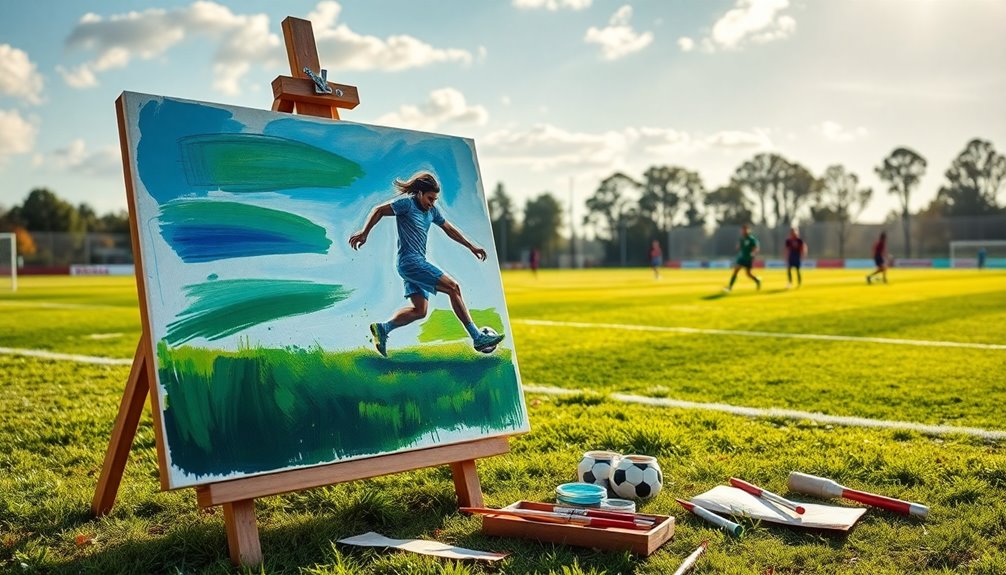
When showcasing your soccer art, choosing the right medium can make a big difference in how your work is perceived.
Whether you opt for traditional materials or digital tools, each choice can highlight different aspects of the sport's energy and movement.
Once you've created your pieces, display them in a portfolio or online gallery to attract viewers and demonstrate your unique style.
Choosing Your Medium
Selecting the right medium for your soccer art can greatly enhance your creative expression. Each medium offers unique advantages, so consider how you want to convey the energy of the game.
For example, acrylic advantages include vibrant colors and fast drying times, making them ideal for quick layering techniques. If you prefer a softer touch, watercolor techniques allow you to capture fluid movements, though you'll need to control your washes to avoid muddiness.
Charcoal sketches can be perfect for those dynamic moments, providing a bold and expressive way to illustrate the intensity of the sport. With digital flexibility, you can experiment with various styles and easily blend different media, giving a modern twist to your soccer illustrations.
Ultimately, don't overlook pastel textures, which can add depth and a unique feel to your artwork, especially when rendering the lush grass and atmosphere of a soccer field.
Consider these points when choosing your medium:
- Enhance vibrancy with acrylics.
- Capture movement using watercolors.
- Express intensity through charcoal.
- Explore styles with digital art.
Choose wisely, and let your soccer art flourish!
Displaying Your Artwork
Once you've chosen the perfect medium for your soccer artwork, showcasing it effectively becomes your next priority. Start by exploring various display options. Quality framing can enhance your pieces, making them visually appealing while protecting them from damage. Properly framed artwork stands out and draws attention.
Next, consider the lighting in your display area. Good illumination highlights details and colors, making your artwork more engaging for viewers. Experiment with different light sources to find what works best for your pieces.
To create a cohesive art theme, group your soccer artworks together. This strategy helps tell a story or showcase different aspects of the sport, attracting more attention from your audience.
Participating in local art shows or sports events can also provide valuable exposure. These venues allow you to showcase your soccer artwork while networking with potential buyers and fans.
Lastly, don't underestimate the power of social media. Share high-quality images of your artwork and engage with soccer communities online. This approach not only increases visibility but also connects you with a broader audience passionate about art and soccer.
Conclusion
As you merge the worlds of art and sport, let your pencil dance like a player weaving through defenders. Each stroke captures the heartbeat of the game, breathing life into your canvas. Remember, every masterpiece starts with a single line, just like every goal begins with a pass. So, grab your materials, embrace the energy of the field, and let your passion for soccer illuminate your artwork. Your journey in this vibrant domain has just begun!


